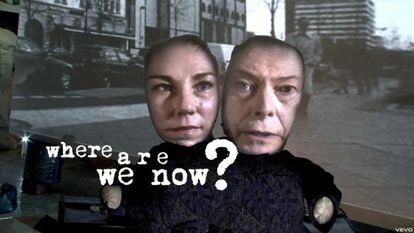The shadow behind David Bowie
The musician has released his first new work in 10 years New Yorker Tony Oursler is the visual mastermind behind the nostalgic video

Where Are We Now?, the single and video with which David Bowie surprised the world last Tuesday, the day of his 66th birthday, has hit like a stone dropped into a murky lake. In just four-and-a-half minutes the British music star pokes his finger into many wounds: the desolation caused by the current economic crisis, and the issues that have to be asked about his advancing age — “Just walking the dead,” he sings.
For the video, this time around he has teamed up with renowned contemporary artist Tony Oursler. And although Bowie has yet to speak on the subject, the New York-born artist has. “I’ve always had a cast of characters whose artistic activities I referred to, and this cast was always changing: from Salvador Dalí when I was a teenager to John Baldessari more recently,” he explains. “But Bowie has always been on that list, and that means a lot to me.”
Oursler is no run-of-the-mill music video director. His works feature in the collections of some of the world’s best museums. He is also an artist with close ties to music: in the 1970s in California he formed a punk band, The Poetics, with fellow artist Mike Kelley, and has also collaborated on several occasions with Sonic Youth. “I’ve done a lot of projects related to the oral and the visual, and the audio components of my work have always had a relationship with my musical activities,” he says.
One trademark of Oursler’s work is his use of video projected over three-dimensional surfaces
“There has always been that bridge for my generation — if you look at many musicians you’ll notice they have often studied at art schools, notable examples including Kim Gordon, Laurie Anderson, David Byrne, David Bowie, Brian Eno. […] David’s been painting pictures with his lyrics, poetry and soundscapes, and it goes further than that. David is a touchstone for many visual artists, I think largely due to his ability to morph himself, which is a very contemporary point of view.”
One of the trademarks of Oursler’s work is his use of video projected over three-dimensional surfaces, such as the ragdolls over which the faces of Bowie and an anonymous woman are superimposed in the new video. “I first met him in 1996 when we did an exhibition together in Italy. David was aware of my work and we eventually collaborated in 1997 for his special 50th birthday concert at Madison Square Garden, where he used my work as a kind of stage setting. I had often wondered what was happening with his music production. When I met him in the 1990s he was working all the time. […] I liked the energy, so I was surprised when he stopped putting out music 10 years ago. And although we kept up our friendship, I had no idea that he was secretly recording new music until he called me about a month ago. He wanted to know if I was available to meet, revealed his secret plan, and we quickly got down to work.”
He notes a couple of things about his new work. “The video took about two weeks from start to finish; we did it with a small but highly skilled crew. I’m lucky to work with some of the best creative and technical young professionals, many of whom are artists in their own right.”
We embedded numerous levels of visual clues for the viewer to discover"
But what about that mystery woman? “Well, some people think that it’s Bjork in the video, but that’s a fallacy. The mystery woman, as she’s come to be known in the press, is artist Jacqueline Humphries, whom I happen to have been married to for the last 10 years, and whom David is quite fond of.”
The promo, he says, is a contemplative piece full of layers of memory collaged together: “We embedded numerous levels of visual clues for the viewer to discover — on first view you’ll pick up only a bit, but on the second or third views you may discover even more references to David’s history and his time in Berlin.
“The video projections behind the characters in the video refer to his time there. It was there he produced the famous, so-called “Berlin Trilogy” of albums, so the new video is about gathering the past as well as moving forward.”










































